Wind propulsion on merchant ships. Opportunity for Polish ship repair yards
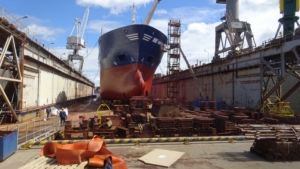
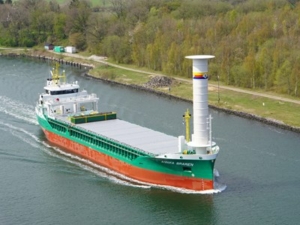
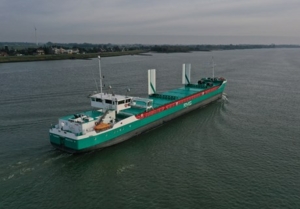
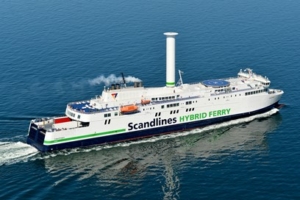
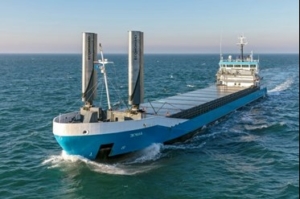
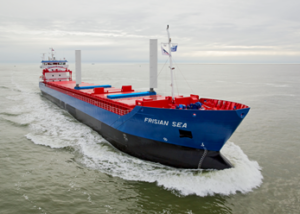
By Marek Grzybowski
The EU Wind Assisted Ship Propulsion (WASP) Project has been a success. The WASP (Wind Powered Ship) project was funded with EUR 5.4 million from the Interreg North Sea Europe program under the European Regional Development Fund (ERDF).
The pictures show the Wind Assisted Ship Propulsion technology, in this case, the VentiFoils, installation process on the cargo vessel of one of the participating beneficiaries. This vessel with its impressive green product on board will contribute to the research, trial and validate the operational performance of a selection of green wind propulsion solutions. More: WASP Gallery
6 new installations
The essence of the project was to install wind devices on already operating ships. Several solutions have been tried. Although the new installations have already proven themselves, research is still being carried out. The installation of proven wind installations on ships is also an opportunity for Polish repair yards.
The project brought together universities and wind power technology providers with commercial ship and ferry operators. It was about designing a wind drive, examining its operation, testing the operation of the drive while the ship is sailing.
Devices operating on five ships were selected to test the selected solutions in real conditions. It was no coincidence that operators in the North Sea were selected, where wind energy can be used very efficiently.
The EU-Interreg North Sea Region project ‘WASP: Wind Assisted Ship Propulsion’ has tested three different wind propulsion technologies. Fuel economy studies have been conducted by third parties to verify actual fuel economy. Other key work on performance indicators, standard sea trials and decision-making tools has also been completed, the project partner says.
Sails in the North Sea
The project lasted three and a half years and contributed to obtaining a lot of very important information regarding the selection of the best installation and operation of ship equipment using wind power. According to the project, the research into the installed devices ‘contributed significantly to the overall development of the wind power [ship propulsion – MG] sector both in the North Sea region and beyond’.
The five wind propulsion installations installed on the ships will continue to be used as demonstrators and examples of how wind propulsion systems can be retrofitted to various types of ships. As expected, the fuel savings from these systems deliver up to a 10% reduction in fuel consumption under the best conditions. Fuel savings are achieved depending on the ship’s route and operational profile.
Different wind power technologies
These installations have also contributed to the creation of three reference points for different wind power technologies and shipping segments that will support shipowners in making investment decisions in the future, WASP project members report.
– We are proud to be part of this amazing project. In the case of WASP installations implemented and assessed during the project, wind technology has proven to be an important element in the process of decarbonizing shipping, emphasizes Marko Möller, special projects manager at Scandlines, one of the ship operator companies involved in the WASP project, and notes that: For Scandlines, the positive results were a decisive factor in installing another rotor sail on the sister ferry “Copenhagen”.
Johan Boomsma, co-owner of Boomsma Shipping, another company that owns a vessel involved in the project, said: “We believe energy efficiency is key and we are always open to new solutions. That’s why we sail with eConowind VentiFoils on mv Frisian Sea.
Unit costs, fuel prices and European ETS regulations
“I think the three main factors – unit costs, fuel prices and European ETS regulations – combine in such a way that wind-assisted propulsion will soon become one of the standard solutions,” predicts Johan Boomsma.
The WASP project played a key role in the development of standard sea trial procedures for ships equipped with wind propulsion installations and in the creation of KPI standards in cooperation with the International Towing Tank Conference (ITTC). These are recommendations that reduce barriers to the implementation of wind power solutions.
Twelve educational events
In addition to developing technical solutions on board ships, the project placed great emphasis on education. Twelve educational events were organized at the partner universities of the project, which took place at the Maritime Academy in Enkhuizen, Delft University of Technology and the World Maritime University.
Although the project has come to an end, its participants decided to inform about the effects of using the installation in the operation of ships. According to the project participants, it is now known that it contributed to the creation of new knowledge useful in the shipping sector. Today, according to them, the North Sea region continues to be at the forefront of the development and application of wind propulsion technology in maritime transport.
WASP website
The WASP website will remain active and the project partners stress that they will continue to build on the foundations created by the project. Visitors to the site can access extensive information on technological installations and even follow the project’s wind-powered vessels.
You can also follow the use of specific solutions on videos. The results section of the website contains copies of all outputs produced by the project partners, including scientific reports, policy papers, scientific articles, financial and decision support tools.
Operators, universities and designers and shipyards who intend to benefit from the experience of the WASP project have access to an extensive knowledge base under the extension: https://northsearegion.eu/wasp/output-library-publications/. The project was implemented by 14 partners from seven countries of the North Sea region, more precisely from the Netherlands, Belgium, Germany, Denmark, Norway, Sweden and Great Britain.
Importantly, the International Windship Association (IWSA), a key project partner, has committed to incorporating the results of the WASP project into its work, as well as to maintain a database of experts on the IWSA website.
Source: IWSA, WASP
